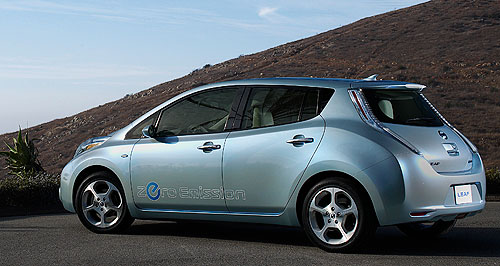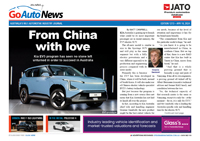Make / Model Search
Future models - Nissan - LeafElectric-vehicle freeze-out threatAutumn Leaf: Nissan's electric Leaf has gone on display in Australia, but the industry questions whether such vehicles are viable without government help. Australia could be green-car backwater without incentives for importers, says FCAI15 Mar 2010 By JAMES STANFORD and PHILIP LORD AUSTRALIA could be left behind the rest of the world on green vehicles without significant government incentives for low-emission cars, the country’s peak motoring body has warned. Europe, Japan and the US have government-funded consumer incentives as high as $10,500 for super-low emission vehicles, helping those markets to attract the lion’s share of world electric vehicle (EV) production as it begins to ramp up. Apart from some minor state level tax relief, no such incentives are in place in Australia. The arrival of two electric Mitsubishi i-MiEV teaser vehicles and a Nissan Leaf display car gained mainstream media attention over the past few days, but Federal Chamber of Automotive Industries (FCAI) chief executive Andrew McKellar said a lack of significant consumer incentives could make it difficult for the Australian importers to introduce electric vehicles, especially when they were competing with countries offering incentives for the small numbers of such models being produced. “It is going to be a very competitive situation globally to secure supply in the early stages,” Mr McKellar told GoAuto. “We have to face up to the reality that there will initially be a very limited supply.”  Left: Mitsubishi i-MIEVs are unloaded in Brisbane. Below: Nissan Leaf. Left: Mitsubishi i-MIEVs are unloaded in Brisbane. Below: Nissan Leaf.Mr McKellar said Australia would only be able to significantly reduce its automotive carbon emissions by introducing green technology for local and imported cars. “The biggest reduction will come from new technology, and unless we can access that technology, there is a risk we will fall behind the curve,” he said. “The reality is that other national governments are already offering significant incentives and we must determine whether or not we want full and early access to some of these technologies or whether we are going to be content to slip back and let others take the lead.” Mitsubishi has imported two i-MiEV vehicles – the first all-electric mainstream vehicles to achieve Australian Design Rule compliance – but they are demonstration vehicles that will be lent to potential fleet customers and key government officials for short periods. The company plans to introduce more i-MiEVs for leasing to key customers late this year and early next year. GoAuto can confirm that while Mitsubishi Australia plans to start offering i-MiEV for sale next year and has a verbal agreement with Mitsubishi top brass in Tokyo to that effect, the plan has not yet been formally approved. The issue for the company is that i-MiEV production next year will be limited to just 18,000 vehicles, with half of those going to PSA Peugeot-Citroen in Europe under a model-sharing arrangement. Mitsubishi distributors in big markets such as Japan and the US will have their hands out for as many of the remainder as they can get, as will most other markets. The likely starting price for the i-MiEV in Australia will be around $70,000, so it is not surprising that Mitsubishi Australia would appreciate government incentives to make it more attractive to both the consumer and itself. The Australian division is also likely to have a tough task convincing senior Mitsubishi executives to free up steady supply for Australia when attractive incentives are available in so many other countries. “We are facing competition from other countries with more developed incentive programs,” Mitsubishi spokeswoman Lenore Fletcher told GoAuto. Nissan this week confirmed it would press ahead with the introduction of its Leaf electric vehicle in 2012, regardless of whether the federal government decides to introduce low-emission incentives. However, Nissan Australia CEO Dan Thompson said federal government support would be needed to make the Leaf a tenable mass-market proposition in the short term. “We obviously need the consumer incentives in place to make the financial proposition palatable for the mass market, otherwise it’ll be a niche product, and only the early adaptors will be there for the first few years,” he said. Mr Thompson said support along the lines of the US government’s EV subsidy of up to $8200 would be necessary here for the Leaf to gain significant volume in the local market. “You don’t have to look much further than looking in the paper and see what’s been done in the US,” he said. “With that level of support, it’s making the proposition of mass-marketing our cars effective. It puts it right in the range it needs to be.” Mr Thompson said that without a significant EV subsidy, only improved economies of scale would make the Leaf affordable, and that would not occur until the second-generation of Nissan’s small EV hatch arrived in about 2015. “My frustration is that why do we have to wait until 2014 or 2015 when we can do it (with a Federal subsidy) in 2012,” Mr Thompson said. Last year, the FCAI set-up an electric vehicle working group to formulate an industry-wide position on electric and petrol-electric vehicles. GoAuto understands some members of this committee are keen to press for a government incentive of at least $5000 for electric vehicles, which is scoffed at by some other members who point to Honda and Toyota which have imported hybrids for years without government incentives. Some working group members believe that while local manufacturers and technology providers are covered by the $1.3 billion Green Car Innovation Fund, there is nothing to encourage importers to introduce green vehicles. The committee is putting the final touches to a submission to a federal government working group that is looking at the future of vehicle emissions policies and is due to report to the Council of Australian Governments (COAG) mid-year, while the FCAI members will also enter a submission next month. Mr McKellar is keen to point out that the FCAI is of the opinion that any incentive scheme should encourage customers to consider all kinds of green technology and not just electric. One group pushing for the rapid take-up of electric vehicles is start-up electrification network provider Better Place. Its Australian CEO, Evan Thornley, attended today’s Australasian Fleet Managers Association conference in Melbourne in a bid to convince fleet managers of the benefits of electric vehicles. He said Better Place would spend $600 million on introducing a national public charging and battery swap network in place by the end of 2013. Mr Thornley referred to a recent Deutsche Bank prediction that 119 electric models would be in production around the world by that time, but admits there won’t be many electric vehicles in Australia when the initial Better Place network of electrification and battery swap centres is introduced. “We believe that the mass adoption will begin once the charge station is in place,” he said. “It will be relatively small numbers in the first few years, in the thousands, then the tens of thousands, but we would expect that by the middle of the decade we will start to move into very substantial mass adoption.” Mr Thornley said the number of electric vehicles on Australian roads would be dramatically boosted if a local manufacturer built one. “I think the biggest single variable will be what the Australian industry chooses to do. We think there is a terrific opportunity for the Australian car industry, we make large powerful cars and the disadvantage of making large powerful cars in the real world is that their fuel economy is not as strong and that (fuel economy) is increasing the dominant purchase driver,” he said. “The Australian manufacturers will have a big opportunity there, and if they don’t take up that opportunity then imports will take up that place.” Mr Thornley said consumer incentives would help accelerate the take up of electric vehicles in Australia. “Obviously, if you have more incentives you will have more rapid growth than if you don’t. I think, particularly in the early years, the manufacturers are looking for additional support to help off-set their investment and they will favour environments around the world where they are getting that support,” he said. “I don’t think that means we won’t see any EVs in this country, but of course there would be a lot more if we choose to accelerate the introduction as most of the other countries have done.” Mr Thornley added that a charging and battery swap network, such as the one Better Place is proposing, would also be required for electric vehicles to become widespread in Australia.  Read more26th of February 2010  Victoria throws switch on EV trialUp to 30 electric vehicles to go on trial in five-year public test of plug-insAll future models Alfa Romeo Alfa Romeo Abarth Abarth Alpine Alpine Alpina Alpina Audi Audi Aston Martin Aston Martin BMW BMW Bentley Bentley Chery Chery Brabham Brabham Chrysler Chrysler Chevrolet Chevrolet Cupra Cupra Citroen Citroen DS DS Dodge Dodge Fiat Fiat Ferrari Ferrari Foton Foton Ford Ford Great Wall Great Wall FPV FPV Haval Haval GWM GWM Honda Honda Holden Holden Hummer Hummer HSV HSV Infiniti Infiniti Hyundai Hyundai Jaguar Jaguar Isuzu Isuzu Kia Kia Jeep Jeep Land Rover Land Rover Lamborghini Lamborghini Lexus Lexus LDV LDV Mahindra Mahindra Lotus Lotus Mazda Mazda Maserati Maserati Mercedes-AMG Mercedes-AMG McLaren McLaren MG MG Mercedes-Benz Mercedes-Benz Mitsubishi Mitsubishi Mini Mini Opel Opel Nissan Nissan Peugeot Peugeot Pagani Pagani Proton Proton Porsche Porsche Renault Renault Ram Ram Rover Rover Rolls-Royce Rolls-Royce Skoda Skoda Saab Saab SsangYong SsangYong Smart Smart Suzuki Suzuki Subaru Subaru Toyota Toyota Tesla Tesla Volvo VolvoMotor industry news |
Click to shareNissan modelsResearch Nissan All future models Alfa Romeo Alfa Romeo Abarth Abarth Alpine Alpine Alpina Alpina Audi Audi Aston Martin Aston Martin BMW BMW Bentley Bentley Chery Chery Brabham Brabham Chrysler Chrysler Chevrolet Chevrolet Cupra Cupra Citroen Citroen DS DS Dodge Dodge Fiat Fiat Ferrari Ferrari Foton Foton Ford Ford Great Wall Great Wall FPV FPV Haval Haval GWM GWM Honda Honda Holden Holden Hummer Hummer HSV HSV Infiniti Infiniti Hyundai Hyundai Jaguar Jaguar Isuzu Isuzu Kia Kia Jeep Jeep Land Rover Land Rover Lamborghini Lamborghini Lexus Lexus LDV LDV Mahindra Mahindra Lotus Lotus Mazda Mazda Maserati Maserati Mercedes-AMG Mercedes-AMG McLaren McLaren MG MG Mercedes-Benz Mercedes-Benz Mitsubishi Mitsubishi Mini Mini Opel Opel Nissan Nissan Peugeot Peugeot Pagani Pagani Proton Proton Porsche Porsche Renault Renault Ram Ram Rover Rover Rolls-Royce Rolls-Royce Skoda Skoda Saab Saab SsangYong SsangYong Smart Smart Suzuki Suzuki Subaru Subaru Toyota Toyota Tesla Tesla Volvo VolvoMotor industry news |











Facebook Twitter Instagram